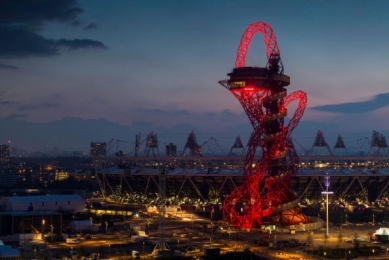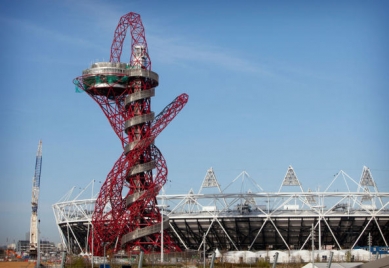
The viewing Olympic tower in London by Anish Kapoor
The Jubilee 30th Summer Olympic Games, which London will host in just two months, has been adorned by another striking structure aspiring to become a symbol of the entire sporting event. In mid-May, after eighteen months since the project's first presentation to the public, the 'ArcelorMittal Orbit' tower by Indian-British sculptor Anish Kapoor was completed. Behind the twisting steel structure stands another Indian native - the main figure from the engineering firm Arup, Cecil Balmond. The financing of the 115-meter tall tower, at a cost of £23 million, was largely covered (19 million) by Indian steel magnate Lakshmi Mittal. The rust-red twist now represents the tallest sculpture in Great Britain, which exceeds New York's Statue of Liberty by 22 meters. Visitors can climb 455 steps to the observation deck (300m²), from where they are offered a unique view not only of the Olympic area but also of the London skyline, twenty miles away.
The construction of the 'ArcelorMittal Orbit' used 2,000 tons of steel, with 63 percent being recycled. As usual, this building has not only sparked positive reactions but has already earned nicknames like 'crumpled trash can' or 'a cross between the Eiffel Tower and Tatlin's Tower'.
The final shape of the tower emerged from a competition that attracted 50 artists. A nine-member committee selected the top three projects, which included director of the Serpentine Gallery Julia Peyton-Jones and curator Hans-Ulrich Obrist, and the judges unanimously decided on Anish Kapoor's winning project.
More information >
The construction of the 'ArcelorMittal Orbit' used 2,000 tons of steel, with 63 percent being recycled. As usual, this building has not only sparked positive reactions but has already earned nicknames like 'crumpled trash can' or 'a cross between the Eiffel Tower and Tatlin's Tower'.
The final shape of the tower emerged from a competition that attracted 50 artists. A nine-member committee selected the top three projects, which included director of the Serpentine Gallery Julia Peyton-Jones and curator Hans-Ulrich Obrist, and the judges unanimously decided on Anish Kapoor's winning project.
More information >
The English translation is powered by AI tool. Switch to Czech to view the original text source.




0 comments
add comment
Related articles
0
29.08.2011 | Mobile concert hall by Arata Isozaki
0
07.01.2011 | The Olympic Village Tower is set to become one of the landmarks of London
3
31.03.2010 | In the Olympic park in London, a giant Kapoor sculpture will rise
0
31.10.2009 | Mittal will pay for a monumental sculpture for the London Olympics











